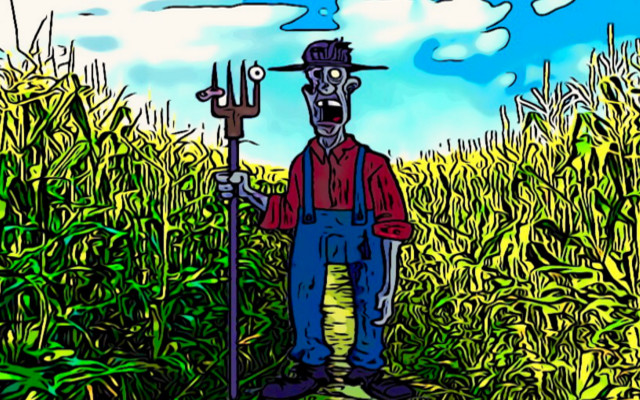GMO Safe for consumer health and the environment? It is the
fake news
artfully constructed on the news of a study
by the Scuola Superiore Sant’Anna and the University of Pisa,
published in Scientific Reports
. Which is distinguished, however, by the partiality of the analysis. Critical notes to follow.
Safe GMOs? Which ones, and against which parameters?
News agencies – as the mainstream media Who took up its releases, without bothering to verify the news – have rendered service to the Big 6. The six corporations that control 75 percent of the global market for agrotoxics and seeds functional to them.
It has been theorized that GMO corn. would be harmless, and indeed even beneficial, to human health and the environment. A poor attempt to counter the public sentiment of European citizens, who instead continue to speak out against GMOs at the table
and the
agrotoxics
broad-spectrum, such as glyphosate
.
On closer inspection, however, the Pisan researchers merely collected some studies already carried out elsewhere. Referring only to GMO corn designed to resist pesticides, from the unique perspectives of crop and biomass yields as well as off-target insect survival. In contrast, the health of other species, including humans, has not been given any consideration. Least of all to the environment.
GMO corn, the University of Pisa study.
The University of Pisa study reviewed 271 scientific publications on transgenic corn crops between 1996 and 2016. Just 6 percent of the evaluated studies came from South America, a large pool of transgenic crops, while the 74% come from North America. (1) In almost all from the U.S., the large open-air Franken-seed laboratory whereMonsanto is based , already known for manipulating research. (2)
The Pisa researchers extrapolated only a few parameters, concluding that GMO corn:
– would have a higher yield than conventional corn crops, ranging from 5.6 to 24.5 percent,
– would help to limit
insects that are harmful
to plants,
– would reduce the presence of hazardous contaminants, such as the mycotoxins (- 28.8%) and the fumonisins (-30.6%).
Abstract and out-of-context data that neglect the fundamentals of agricultural economics. Farmers who intend to devote themselves to biotech are indeed forced to repurchase sterile GMO seeds every year, in addition to increasing amounts of agrotoxics. Because pests adapt quickly to new obstacles, even on plants designed to repel them, more and more poisons are needed. (3)
GMOs and the environment, the data that are missing
Environmentalists such as Marco Affronte and Angelo Bonelli, like Slow Food founder Carlin Petrini, have called out the essential value of biodiversity, but without doubting the scientific value of the Pisa study.
Instead, the Pisa researchers failed to consider-among other crucial points for an analysis worthy of the name-the very impact on biodiversity and Co2 emissions of the biotech production system. (4)
They also failed to examine studies on water poisoning caused by pesticides. We cite as an example the research published in 2014 in the Journal of the American Water Resources, which detected the presence of glyphosate and AMPA (aminomethyl-phosphonic acid, another deadly agrotoxic) on soils and sediments, ditches and canals, rainfall, rivers and streams, lakes and ponds, marshes, deep and surface waters, in the 38 U.S. states monitored systematically for 10 years.
GMOs and health
Studies on the influence of GMOs on human health are totally lacking. In particular-unfortunately, since industrial-scale Franken-seed cultivation began 20 years ago-data about long-term and very long-term effects are lacking.
The only certain fact
is the extreme dangerousness of pesticides, such as glyphosate and dicamba
, which GMO plants are programmed to resist. But the Pisans have been careful not to consider any of the numerous studies-not least that of the Iarc, the WHO Agency for Research on Cancer – that attest with certainty to the adverse effects of agrotoxics On the nervous, endocrine and reproductive systems. (5) Also causing DNA damage and increased risks of cancer.
These poisons carry over into drinking water and breast milk, which from India to Germany are themselves found to be contaminated in alarming amounts. 34,000 agrotoxicos intoxications in Brazil recorded by the Ministry of Health from 2007 to 2014. Glyphosate and AMPA residues, it goes without saying, in almost all of the urine samples analyzed in a recent Argentine study.
Enough. And if not, thefree ebook ‘GMO the Big Scam‘ is referred to.
Dario Dongo
Notes
(1) Although transgenic crops in Brazil (42.2 million ha) and Argentina (24.3 mln ha) are almost equal to those in the U.S., 70 mln ha (2014 data)
(2) The infamous
Monsanto Papers
https://www.greatitalianfoodtrade.it/consum-attori/glifosato-il-rapporto-dell-echa-agenzia-chimica-europea-trascura-la-falsità-dei-dati-prodotti-da-monsanto-la-corporation-ora-sotto-processo-in-usa
(3) In the United States of America alone, pesticide consumption, thanks to the spread of biotech crops, increased by 183 thousand tons between 1996 and 2011 (Benbrook, 2012)
(4) The so-called carbon footprint, on the other hand, is an essential part of the so-called Life Cycle Assessment (LCA) that in modern society should preside over every decision on anthropogenic activities, starting with industrial agriculture. Given that this still plays a primary role in CO2 and greenhouse gas emissions, and is certainly influenced by factors such as the production and use of fertilizers and pesticides
(5) Reference is made in this regard to the condemnation of the European Commission by the Court of Luxembourg for its delay in adopting the definition of endocrine disruptor on the basis of which to base the protection of citizens. See https://www.greatitalianfoodtrade.it/salute/interferenti-endocrini-la-commissione-latita
Dario Dongo, lawyer and journalist, PhD in international food law, founder of WIISE (FARE - GIFT - Food Times) and Égalité.




